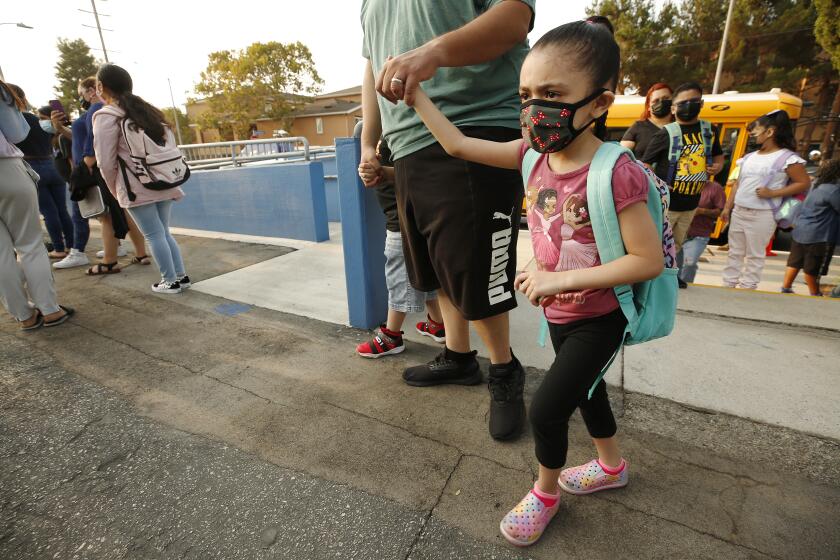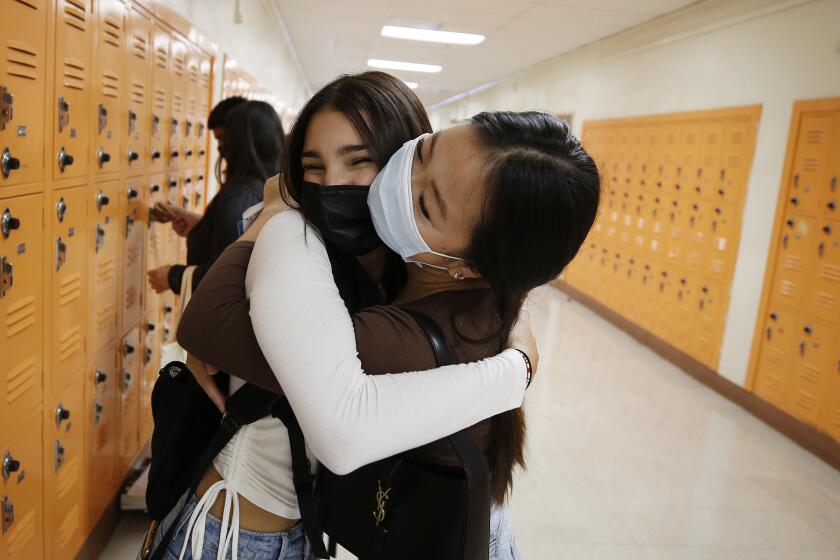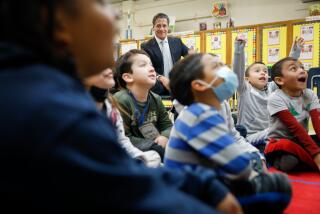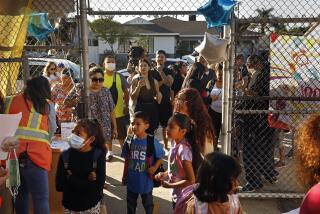$350 million. 1,000 healthcare workers. 500,000 tests weekly. Inside LAUSD’s virus testing effort
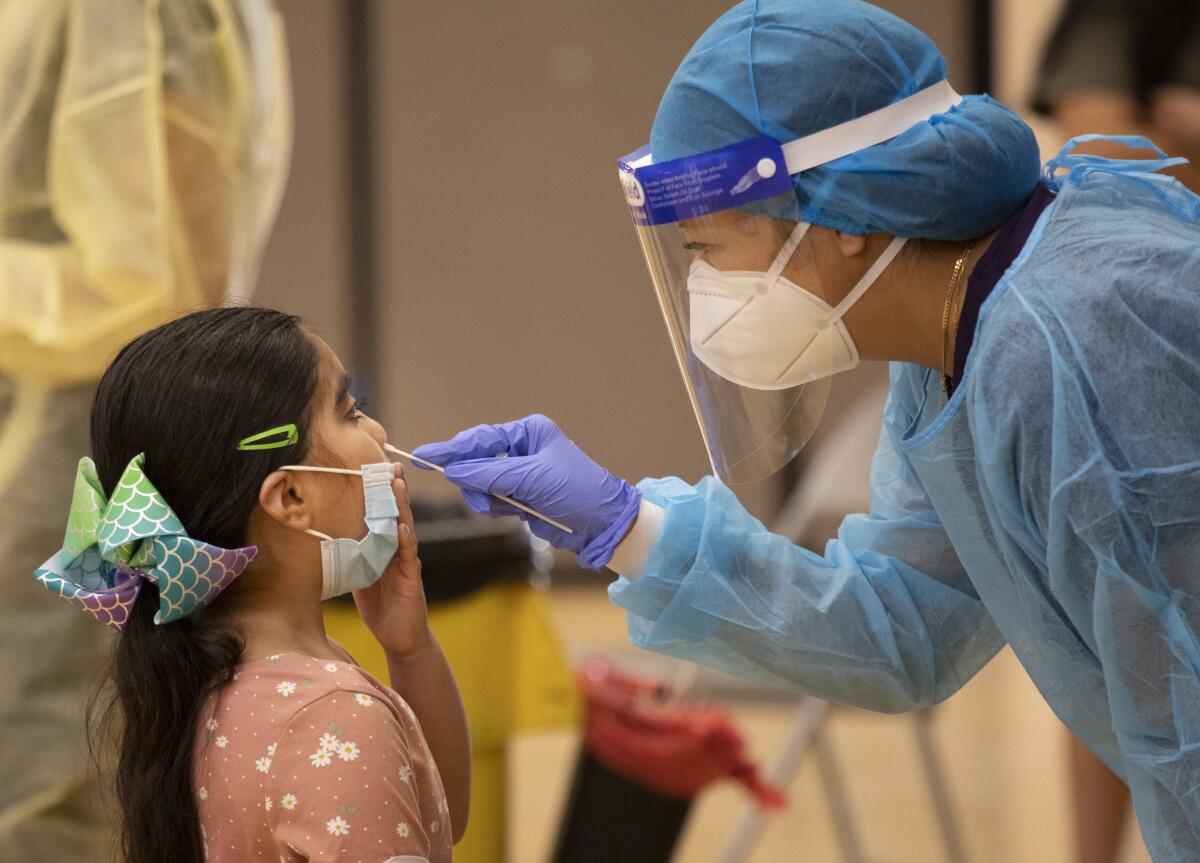
- Share via
The scene at Telfair Elementary in the days leading up to the Monday opening of the school year reflected what will be the new normal across the Los Angeles school district: Students, teachers and staff in line for their coronavirus test.
Emilio Mendoza, 7, held a toy plane as he stood in the queue with his parents. At the check-in table, Emilio pumped hand sanitizer into his palms and rubbed them together. The technician showed him the swab and explained how it worked. She counted out loud to 15 as Emilio followed along on his fingers — and then it was over. In 24 hours Emilio’s parents were texted the result: negative.
“He’s not vaccinated, so for us, it’s always going to be a little bit of a concern, uncertainty, especially if there are outbreaks,” said his mother Liliana Curioca, who is also a Telfair teacher. “But testing will help.”
Emilio’s nasal swab test is a starting point in L.A. Unified’s colossal effort to screen every single student, teacher and staff member — more than half a million people — once a week for the foreseeable future.
For the first time, the most ambitious school district testing program in the nation is being put to its own test with the opening of more than 1,000 schools throughout the sprawling system. LAUSD is expected to be the single largest source of coronavirus testing in L.A. County — and public health experts said it will serve as a case study on how effectively coronavirus transmission can be controlled at schools where everyone is regularly tested.
The rollout comes amid growing urgency among school districts to ensure a safe return to the classroom amid a rapid increase in coronavirus cases due to the highly infectious Delta variant. The tests are mandatory, and the numbers are head-turning: 500,000 tests a week, a cost of $350 million, 1,000 healthcare technicians, 30 lab workers rapidly turning around tests, and even two plane trips daily to speedily deliver the test samples to a Northern California lab.
Students returned amid excitement and trepidation — while enduring lengthy waits to get inside campuses
“Since the very beginning of the pandemic, L.A. Unified has really tried to take a leadership role in saying that when students return to in-person instruction, we have to have the highest safety standards possible to reassure parents we’re doing everything we can to keep students safe,” said L.A. Unified consultant Jim Morris, a formerly retired senior administrator who is helping marshal reopening efforts.
The testing requirement is in addition to LAUSD’s Friday order that mandates vaccinations for all teachers and other staff. The district’s requirement for vaccinations and weekly testing makes its policy stricter than California rules. Last week Gov. Gavin Newsom ordered all school staff to be vaccinated or submit to weekly coronavirus tests.
Otherwise, guidelines recommend but do not require school-based coronavirus testing for everyone on campus, and school districts are responsible for determining who to test and how often.
How it works
The first baseline round of testing ran from Aug. 2 through Aug. 14. No one will be allowed on campus Monday without proof of a negative test. But on the first day of school, efforts will be made to provide students with quick-read antigen tests to get them in the door, officials said. These tests can generally detect if a student is especially contagious but are less effective than the district’s standard PCR test at detecting asymptomatic infections, which still pose a risk. The PCR tests, however, require processing at a lab.
LAUSD does not have plans to release its baseline data to the public, a district spokesperson said. The district also declined to release data on how many students had completed a baseline test by Friday.
Students across California are returning to a very different school experience. Here are answers to common questions about vaccines, testing, masks and more.
On Wednesday, the line at Northridge Middle School wrapped around the sidewalk and down the block. Some families waited as long as an hour, Principal Richard Ramos said.
“Every day, nonstop,” Ramos said as families filtered into a multipurpose room that had been transformed into a check-in station. “‘Quiero mi hijo pa’tras a la escuela.’ That’s what I’m hearing over and over: ‘ I want my child back in school.’”
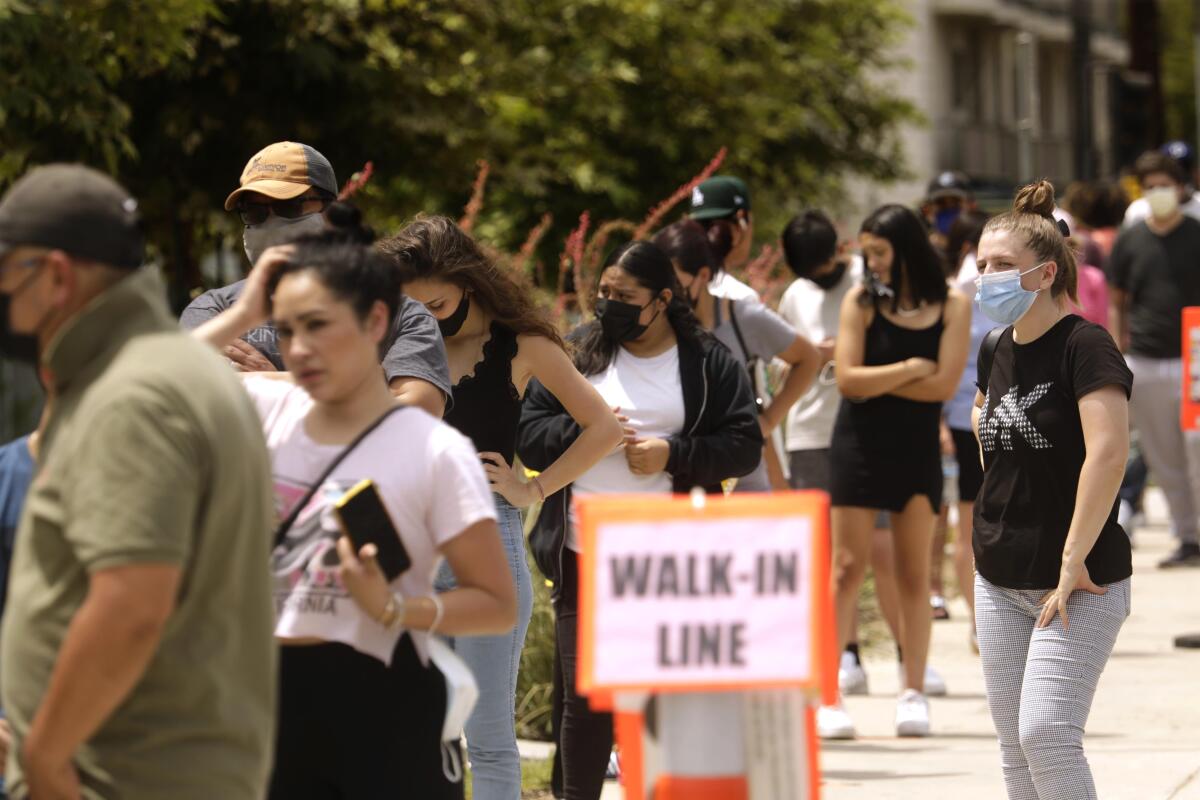
Once school starts, tests will be conducted at every campus by teams deployed in mobile vans, generally once a week.
Licensed healthcare workers — nearly a thousand, across all schools — will offer a choice between a nasal swab or a saliva test. Twice a day, test samples will be trucked to a tarmac in Van Nuys, loaded onto a plane and flown to a Palo Alto lab tasked with delivering results to the district in 24 to 36 hours.
The district said $82 million of the program’s projected $350 million cost will be reimbursed by the L.A. County Office of Education. The district is pursuing Federal Emergency Management Agency funds for the remainder. Last school year, the district spent $106 million on testing, but the program was unable to return students to campus sooner than districts that did not conduct testing. Los Angeles Unified did not reopen until mid-April, after teachers and other school employees had the opportunity to be fully vaccinated.
The testing effort is one of the main legacies of former Supt. Austin Beutner, who stepped down June 30. Early in the pandemic, he used his emergency powers to ramp up the internal testing program with no guarantee that the school system would be reimbursed for it. The powers allowed him to forgo the traditional bidding for contracts, which initially raised some internal concerns.
LAUSD has contracted with Menlo Park-based lab startup SummerBio for nasal swabs, expected to account for 90% of the testing, and UCLA SwabSeq for the saliva tests. Infiniti Health and AMI Expeditionary Healthcare will provide staff to gather the samples for processing. All of these technicians are required to be licensed healthcare workers trained to administer the tests, according to the district.
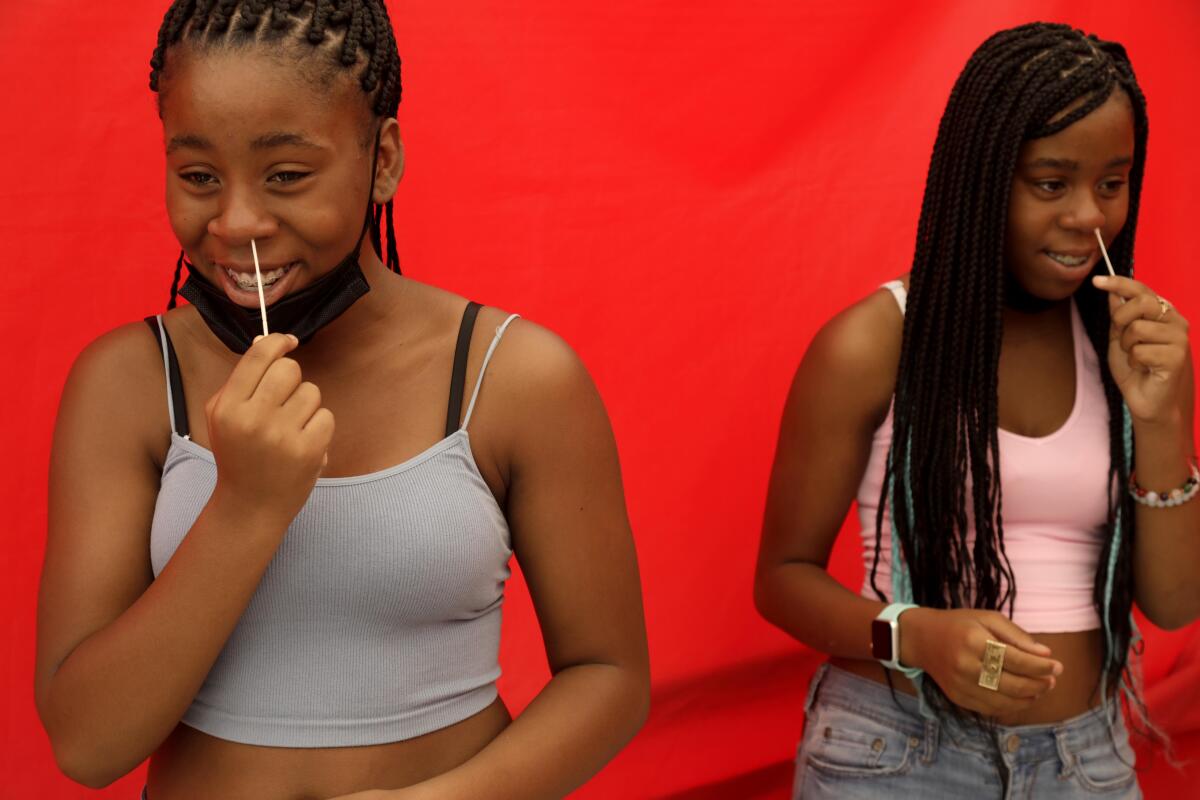
Public health experts said the frequency and scale of LAUSD’s testing is appropriate given the threat of the Delta variant. The Centers for Disease Control and Prevention recommends that districts in moderate- to high-transmission areas offer testing at least once per week to students who are not fully vaccinated.
For now, that includes most K-12 students; vaccines are not yet approved for use in children younger than 12. And, according to L.A. County data, just over half of children ages 12 to 15 have received a dose, while about 6 in 10 teenagers 16 and older remain unvaccinated.
Even LAUSD’s weekly testing will not catch every infection, experts cautioned. A child might be tested on Tuesday and yield a negative result, become infectious on Wednesday, and spread the virus to their classmates before the next scheduled test.
But the regular testing, in tandem with LAUSD’s cohort model, which requires students to remain in the same classroom with the same group of students as much as possible, may prevent an infectious child from spreading the virus to the rest of the school, said Dr. Robert Kim-Farley, medical epidemiologist and infectious-diseases expert at the UCLA Fielding School of Public Health.
“It will allow them to get an impression of what is the current level of disease that’s going on in school-aged children in the community,” Kim-Farley said. “That may inform what their policies will be in going forward — you can adjust testing according to what you’re seeing.”
Keeping small groups of children together is feasible in elementary school, but there will be students switching classes in middle and high schools. In the upper grades, schedules have been modified so there are fewer students flowing between classrooms.
Positive tests prompt action
District policy requires students and teachers who test positive to stay home for 10 days after symptoms first begin, and at least 24 hours after last having a fever. Co-workers and classmates who have been in close contact with the infected person may also be required to quarantine.
Dr. Ilan Shapiro, a physician and spokesman for the American Academy of Pediatrics, stressed that testing is just one part of a layered approach to preventing outbreaks. Mask mandates, health screenings, improved sanitation, frequent handwashing and upgraded ventilation — all part of LAUSD’s safety protocols — should reassure parents.
“It will be uncomfortable, but I think we have done other things that are more uncomfortable, and this kind of testing can make a huge difference for all of us,” Shapiro said.
Districts across California have chosen a range of testing strategies, including voluntary testing and random testing of a certain percentage of staff and students.
But many of those plans will likely evolve in the coming weeks. Gov. Gavin Newsom announced Wednesday that all California school employees must be vaccinated against COVID-19 or submit to a weekly test showing they are not infected with the coronavirus.
San Diego Unified, the state’s second-largest school district after L.A. Unified, will require weekly testing of athletes, and provide optional weekly testing for unvaccinated students. Vaccinated staff and students will have access to testing if they are symptomatic.
San Francisco Unified is recommending that students and staff get tested if they have symptoms, but will not require tests. San Jose Unified requires that all staff and teachers must be vaccinated or agree to be tested twice weekly — going beyond the new state mandate — though the district will not test students.
El Rancho Unified School District, which remained completely online for the 2020-21 school year, is requiring all staff to undergo mandatory COVID-19 testing every 10 days, Supt. Frances Esparza said. The district is asking parents to pre-screen their child for symptoms every day before school.
What parents are saying
For many LAUSD parents and students, the prospect of weekly testing is a small price to pay — and extra assurance. Others are nervous because they know that, despite testing, their children are still vulnerable to the virus.
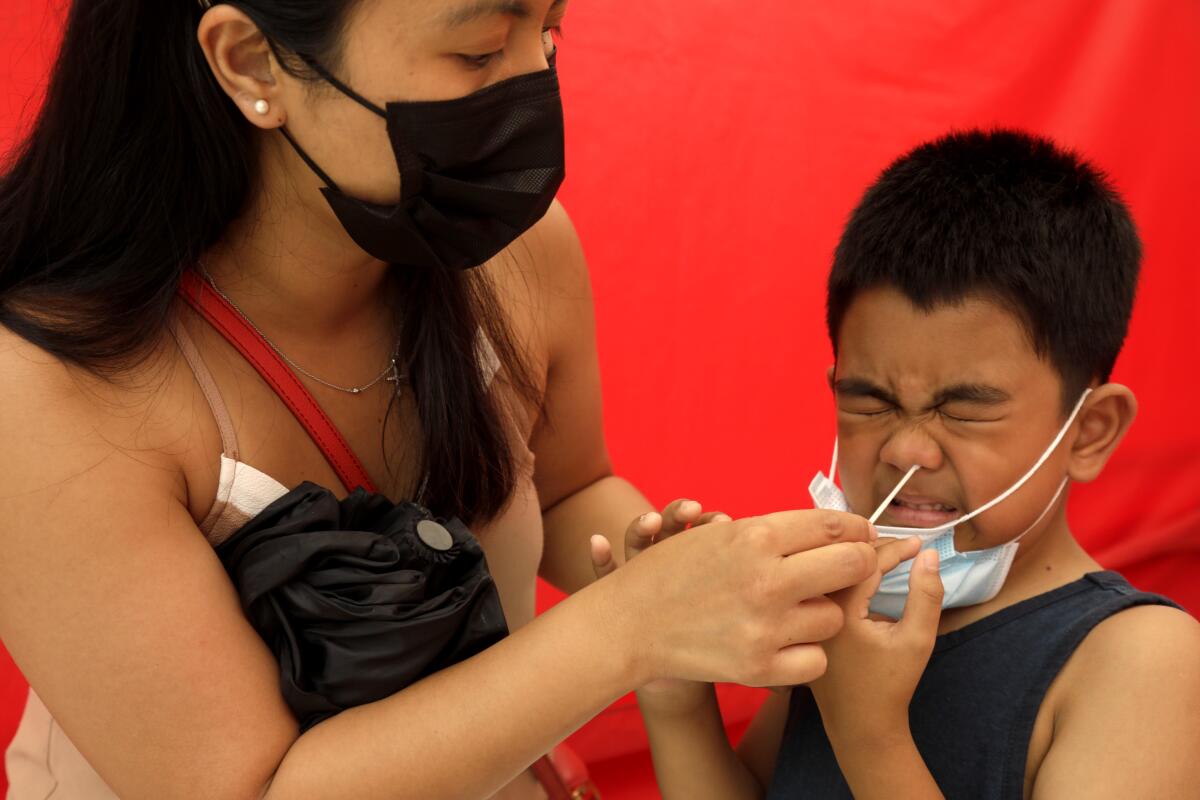
At Northridge Middle School on Wednesday, Raizah Touch held a black umbrella over her 6-year-old, Skyzell, as they waited for his test. She had debated whether to send Skyzell back to school as she saw cases surge because of the Delta variant.
“We’re going to try it, maybe for the first two weeks,” Touch said as the line moved forward.
Because Skyzell isn’t old enough to get vaccinated, Touch said the test is a crucial precaution, beyond keeping Skyzell home. But he could still catch the virus and spread it.
“COVID testing is good,” Touch said, “But there’s still that uncertainty.”
More to Read
Sign up for Essential California
The most important California stories and recommendations in your inbox every morning.
You may occasionally receive promotional content from the Los Angeles Times.
